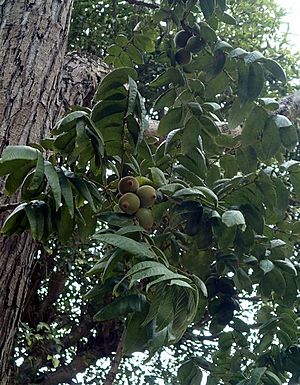Colombian walnut facts for kids
Quick facts for kids Colombian walnut |
|
|---|---|
 |
|
| Leaves and fruits. | |
| Conservation status | |
| Scientific classification | |
| Genus: |
Juglans
|
| Species: |
neotropica
|
| Synonyms | |
|
Juglans andina Triana & Cortés |
|
The Andean Walnut (scientific name: Juglans neotropica) is a special type of plant found in the Juglandaceae family. This family includes many well-known walnut trees. You can find the Andean Walnut growing in countries like Colombia, Ecuador, and Peru. Sadly, it is an endangered plant. This means it is at risk of disappearing forever, mostly because its natural home is being destroyed.
People call this tree by many names, such as Colombian walnut, Ecuadorian walnut, or just Andean walnut. In some places, it's known as nogal, cedro negro, cedro nogal, or nogal Bogotano.
Contents
Growing and Caring for Andean Walnuts
The Andean Walnut is a tree that grows slowly. It can reach impressive heights of up to 40 meters, which is about as tall as a 13-story building! Its bark is reddish-brown and has grooves, and its top part, called the canopy, is shaped like an oval.
The leaves of this tree are quite long, about 40 centimeters. They are grouped at the ends of the branches. Like all walnut trees, their leaves have a special shape with a jagged or saw-like edge.
Where Andean Walnuts Grow Best
This tree likes soil that is loose and full of nutrients. It also seems to do well in slightly muddy places. The best soil for it is not too acidic and not too alkaline. It cannot grow in very chalky soils or extremely acidic conditions.
Andean Walnuts are found in mountains, usually between 1600 and 2500 meters high. This is where the average temperature is between 16 and 22 degrees Celsius. They need a lot of rain, about 1 to 3 meters per year, spread out evenly. These trees grow especially well near running water. You can find them naturally in many types of forests, especially in cloud forests, which are misty and humid.
How New Trees Grow
New Andean Walnut trees usually start from seeds, which are the nuts themselves. To help them grow, the nuts are sometimes gently rubbed with sandpaper. Then, they are planted in moist sand for about four months in a cool place. In nature, new trees often sprout where nuts fall and get covered by fallen leaves.
Like most walnut trees, the Andean Walnut has a special ability called allelopathy. This means it releases chemicals that can stop some other plants from growing nearby. However, certain plants like Anthuriums and Philodendrons are not affected and often grow on the walnut tree.
The Fruit of the Andean Walnut
The Andean Walnut produces fruit that you can eat. When the fruit is ready, its outer husk turns yellow-green. People collect the fruit either by picking it up from the ground after it falls or by harvesting it from the tree when the husks look ripe. Be careful, though! The juice from the fruit husk is a strong dye and can stain your hands and clothes.
Inside the husk is a nut. This nut has a much harder shell than the walnuts you might buy at the store. But the nut meat inside tastes very similar, maybe even a little sweeter. These nuts, called "Tocte," are often sold in farmer's markets in Ecuador. The process of removing the husk often turns the nut shells black.
Natural Dyes from the Fruit
The unripe fruit husks can make a strong yellow dye. You don't need any special chemicals to make the color stick. Ripe fruits make a strong red to brown dye. If you cook these ripe fruits in an iron pot, they can even make a deep black dye!
To get the walnut out, the fruits need to soak in water for 24 to 48 hours. It's important not to let them ferment (start to rot). After soaking, you can remove the softened pulp by hand to get to the walnut inside. A kilogram of nuts can have anywhere from 20 to 200 walnuts. The best temperature to store the nuts is between 4 and 6 degrees Celsius.
Wood from the Andean Walnut
The wood of the Andean Walnut is very hard and strong. Because of this, it is highly valued. People use it to make beautiful cabinets, floors, and thin sheets called veneers. It's also used for utensils and other decorative items. In South America, this wood is known as nogal. It is one of the most expensive woods you can buy there.
See also
 In Spanish: Nogal para niños
In Spanish: Nogal para niños



